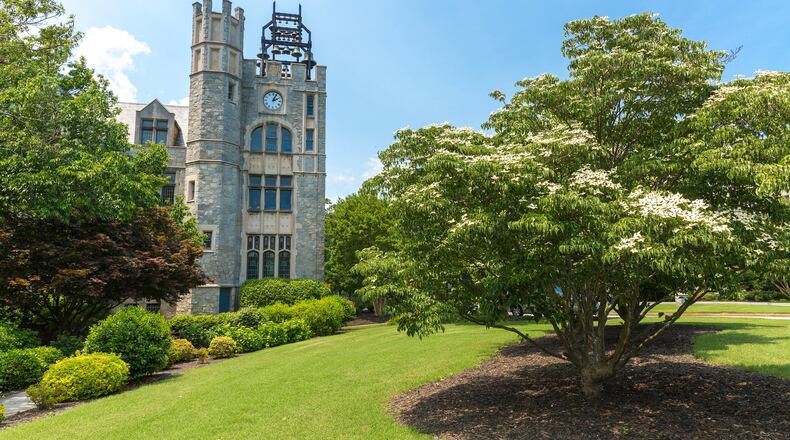The envelopes are postmarked from small towns and big cities throughout the U.S. and at least a half-dozen foreign countries. For every thick, expertly tabbed and indexed report, there are many more forms filled out by hand and paper-clipped to aging snapshots or newspaper articles.
There’s a VHS tape submitted by a town in Massachusetts. And the occasional charming letter from a child, complete with penciled misspellings and schematics to the family home.
“Please registar (sic) my time capsule,” a third-grader from Missouri wrote in 1999, providing the street address of her house. “I will buried (sic) it under my slide on the west side of my house.”
Technically, the material that's carefully packed inside five sturdy boxes and housed on shelves at the Archives and Special Collections of the Philip Weltner Library at Oglethorpe University, is part — but not all — of an ambitious registration project launched years ago by the Atlanta-born International Time Capsule Society (ITCS).
Emotionally, though, the collection speaks to something much deeper and more human than that.
“You define yourself when you do a time capsule,” said Paul Hudson, a history professor at Georgia State University Perimeter College in Clarkston. “People always ask, ‘What should I put in it?’ There’s no easy answer to that.”
It was becoming a one-stop answer shop of sorts on the arguably quirky subject of time capsules that led Hudson, then Oglethorpe’s registrar and a history lecturer, to found ITCS with three other experts in 1990. Based at Oglethorpe’s Gothic Revival-style campus that’s steps away from the hustle and bustle of Peachtree Road in Brookhaven, ITCS promoted the “careful study” of time capsules — defined by the founders as “a container used to store for posterity a selection of objects thought to be representative of life at a particular time.”
They created a Time Capsule Registration form, and encouraged submissions from, well, everywhere. A surprisingly comprehensive set of questions covering everything from the purpose and precise location of a capsule to when it’s to be opened and what’s inside (“from the important to the trivial”), the registry was part of ITCS’ ambitious goal of “document(ing) all types of time capsules throughout the world.”
While the ITCS is currently inactive, people haven't stopped registering their time capsules. There's an online version of the form now that automatically inputs information to a spreadsheet, and two to three new ones arrive weekly, said Eli Arnold, director and university librarian of Oglethorpe's Weltner Library. The total amount of registrations submitted is thought to number in the thousands.
Somewhere up there, Thornwell Jacobs must be smiling at what he helped inspire.
As Oglethorpe's president from 1915 to 1943, Jacobs was the driving force behind reviving the university that had originally opened outside Milledgeville in 1838, then shut down during the Civil War. Jacobs is credited with moving the school to its present high-profile location, awarding honorary degrees to the likes of Amelia Earhart and Franklin Delano Roosevelt and — in a move that really put Oglethorpe on the map — inventing the modern-day time capsule.
Or, as he irresistibly dubbed the novel project he conceived in 1936, then spent four years turning into reality: "The Crypt of Civilization."
"Thornwell Jacobs wanted to preserve things for posterity, but he was also a publicity guy," said Arnold. "News organizations all over the world covered it for years, and everyone wanted to send something to be included in the Crypt."
No less an authoritative source than the Guinness Book of World Records declared the Crypt “the first successful attempt to bury a record of this culture for any future inhabitants or visitors to the planet Earth.” Located in the basement of Phoebe Hearst Memorial Hall, it’s encased in a reinforced concrete and granite room measuring 20 feet long by 10 feet wide and high. Scheduled to be reopened in the year 8113 — yes, really — it’s filled with works of art (hundreds of classic books on microfilm, and an original copy of the “Gone With the Wind” script); artifacts of politics and popular culture (voice recordings of Hitler, FDR and Popeye the Sailor); beloved pastimes (Lincoln Logs, and a specially created and sealed ampule of Budweiser), plus thousands more items.
“Nothing has been left to chance,” The Atlanta Journal wrote the day before the Crypt was sealed up behind a massive steel door in an elaborate ceremony on May 28, 1940. Written copies of the Crypt’s history and location were being distributed around the world, the Journal reported, due to “the fact that Atlanta may be no more in the year 8113.”
So far, so good. It’s nearly 2018 and Atlanta’s still here. So is the Crypt of Civilization, although the site (actually, the outer door and a plaque) is only available for viewing on certain occasions now. Hudson’s academic career eventually took him away from Oglethorpe, although he’s still a sought-after speaker and expert source on time capsules, Jacobs and the Crypt.
The Crypt section of Oglethorpe's website explains that the ITCS is "currently … not active," but also provides a link to the registration form. Occasionally, completed forms still arrive by mail, said Arnold, who hopes to one day incorporate all the material in those carefully maintained Archives boxes into one "nice spreadsheet" of time capsule registrations.
“We want to be good stewards of people’s information and expectations,” Arnold said.
Mostly, it appears they're a very patient people. Take, for instance, the Minnesota middle school class that registered its time capsule in May 1996. Attached to the back of the form is a two-page list containing students' names, addresses and home phone numbers — along with a neatly typed message across the top:
“Please contact the following people in the year 2049.”
IN RELATED NEWS:
About the Author
The Latest
Featured







